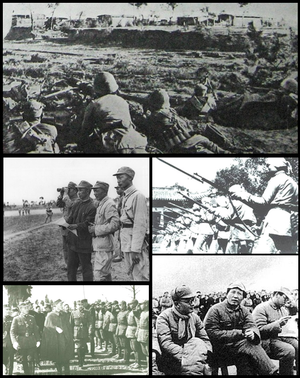Cheenese Ceevil War
The Cheenese Ceevil War wis a ceevil war focht atween the Kuomintang (KMT or Cheenese Naitionalist Pairty), the governin pairty o the Republic o Cheenae an the Communist Pairty o Cheenae (CPC).[6] The war began in Aprile 1927, amidst the Northren Expedition.[7] The war representit an ideological split atween the Wastren-supportit Naitionalist KMT, an the Soviet-supportit Communist CPC. In mainland Cheenae the day, the war is mair commonly kent as the War o Liberation.
| Cheenese Ceevil War | |||||||
|---|---|---|---|---|---|---|---|
 Clockwise frae the tap: Communist troops at the Battle o Siping, Muslim soldiers o the NRA, Mao Zedong in the 1930s, Chiang Kai-shek inspectin soldiers, CCP general Su Yu investigatin the front field shortly afore the Menglianggu Campaign | |||||||
| |||||||
| Belligerents | |||||||
|
1927–1949
|
1927–1949 | ||||||
|
1949–1950 |
1949–1950 | ||||||
| Commanders an leaders | |||||||
|
Chiang Kai-shek |
| ||||||
| Strenth | |||||||
|
4,300,000 (July 1945)[4] 1,490,000 (Juin 1949) |
1,200,000 (Julie 1945)[4] 4,000,000 (Juin 1949) | ||||||
| Casualties an losses | |||||||
| ~1.5 million (1945–1949)[5] | ~250,000 (1945–1949)[5] | ||||||
|
1928–1936: ~2 million Militar Casualties | |||||||
The civil war continued intermittently till the Seicont Sino-Japanese War interruptit it, resultin in the twa pairties formin a Seicont Unitit Front. Japan's campaign wis defeatit in 1945, markin the end o Warld War II, an Cheenae's full-scale ceevil war resumed in 1946. Efter a further fower years, 1950 saw a cessation o major military hostilities—wi the newly foondit Fowkrepublic o Cheenae controllin mainland Cheenae (includin Hainan Island), an the Republic o Cheenae's jurisdiction bein restrictit tae Taiwan, Penghu, Kinmen, Matsu an several ootlyin Fujianese islands. Tae this day, syne nae armistice or peace treaty haes iver been signed, thare is controversy as tae whether the Ceevil War haes legally endit.[8] The day, the twa sides o the Taiwan strait hae close economic ties.[9]
See anaw
eeditNotes
eeditReferences
eedit- ↑ "China". Encyclopædia Britannica. Encyclopædia Britannica, Inc. 15 November 2012.
- ↑ Gui, Heng Bin (2008). Landing on Hainan Island. China: Great Wall Press. ISBN 9787548300755.
- ↑ Westad, Odd (2003). Decisive Encounters: The Chinese Civil War, 1946-1950. Stanford University Press. p. 305. ISBN 9780804744843.
- ↑ a b Hsiung, James C. (1992). China's Bitter Victory: The War With Japan, 1937-1945. New York: M.E. Sharpe publishing. ISBN 1-56324-246-X.
- ↑ a b c Lynch, Michael (2010). The Chinese Civil War 1945-49. Osprey Publishing. p. 91. ISBN 978-1841766713. Archived frae the original on 11 September 2014. Retrieved 20 Mey 2013.
- ↑ Gay, Kathlyn. [2008] (2008). 21st Century Books. Mao Zedong's China. ISBN 0-8225-7285-0. p. 7
- ↑ Hutchings, Graham. [2001] (2001). Modern China: A Guide to a Century of Change. Harvard University Press. ISBN 0-674-00658-5.
- ↑ Leslie C. Green. The Contemporary Law of Armed Conflict. p. 79.
- ↑ So, Alvin Y. Lin, Nan. Poston, Dudley L. Contributor Professor, So, Alvin Y. [2001] (2001). The Chinese Triangle of Mainland China, Taiwan and Hong Kong. Greenwood Publishing. ISBN 0-313-30869-1.
| Wikimedia Commons haes media relatit tae Chinese Civil War. |